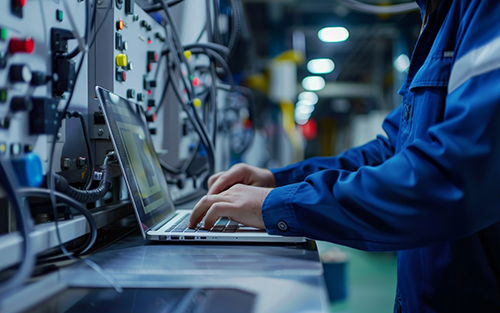- By Rene Simon
- October 03, 2025
- Feature
Summary
Let's examine the technological advances, current state of virtual PLCs (vPLCs), challenges faced in industrial automation and standardization efforts.

According to IEC 61131-1 (2003) [IEC 61131-1–Programmable Controllers–Part 1: General information, 2003], the intended use/function of a programmable logic controller (PLC) is signal processing, specifically for controlling and commanding machines and industrial processes. PLCs are typically associated with/connected to peripherals such as sensors and actuators via inputs and outputs (I/Os), human-machine interfaces (HMIs) and programming and debugging tools (PADTs). The functionality of a PLC is executed on specific hardware and software platforms, personal computers with industrial environment features or general-purpose computers.
It is important to note that PLC functionality and PLC hardware/software are different categories.
Traditional or hard/classical PLCs represent the foundational stage in PLC evolution, often just called PLCs. These systems are typically compact or modular devices featuring specific and proprietary hardware and sensor/actuator interfaces (inputs, outputs). The runtime (RT) for signal/data processing is closely integrated into the hardware, with internal communication systems most often being proprietary (Figure 1). PLCs provide real-time behavior as necessary, primarily operating in a cyclic mode with cycle times as short as 1ms.

The PADTs for PLCs often feature simulators without I/O connections for testing and demonstration purposes, if necessary with a digital twin of the machine/process. These simulators are neither intended nor capable to run a real-world system.
Remote I/O
The next step in PLC evolution is the development of remote I/O (RIO) (Figure 2). Here, the sensor/actuator interfaces are separated to cover longer distances (as required in process industries), handle more signals within available space (critical in manufacturing industries) and save resources.

Soft PLCs
Soft PLCs represent a further advance in PLC evolution. Here, the runtime is separated from the hardware (Figure 3). Technically, the runtime can be deployed on various hardware (lines) of a single vendor. Commercially, it can be shared by multiple vendors.

To achieve this flexibility, soft PLCs must be:
- Adapted to different processor platforms such as x86, ARM, PowerPC, etc.
- Ported to various host operating systems such as Linux, Windows, VxWorks, QNX or none.
- Scalable in terms of performance, functionality, memory and interfaces.
A soft PLC running on different hardware is supported by shared PADTs with none, small or more adaptations. The use of common programming languages, as standardized in IEC 61131-3 [IEC 61131-1 – Programmable Controllers–Part 3: Programming languages, 2025], is a necessary foundation for this technology.
Both remote I/O and soft PLCs have been in parallel development since the 1990s. With their advent, an increasing number of automation devices are incorporating PLC functionality, including industrial PCs, operator panels (Figure 4), remote I/O, drive/robot/CNC controllers and more.

Virtual PLCs
The next major advance in PLC technology is the development of virtual PLCs (vPLCs). In this architecture, the runtime environment is locally separated, while physical inputs and outputs remain on the shop floor. This transition occurs progressively, beginning with onsite servers (Figure 5), advancing to private cloud servers and eventually extending to public cloud servers in future.
Optionally, hard and soft real-time functionalities can be separated, with critical functions such as motion control remaining on the shop floor. New business models are emerging, including “PLC-as-a-service” and “control-as-a-service.”

Virtual PLCs are implemented using container or hypervisor technologies. A container provides an “Isolated execution environment for running software that uses a virtualized operating system kernel.” A hypervisor or virtual machine monitor is “computer software that creates and runs one or more virtual machines.” Hypervisors can be bare metal, running directly on hardware for greater efficiency, or hosted by an operating system for reduced hardware dependency. These implementations can achieve real-time performance.
The introduction of vPLCs is expected to bring several advantages, including:
- Greater flexibility for application development
- Reduced hardware costs through decreased variety and quantity
- Lower maintenance, update, security and energy consumption expenses
- Enhanced scalability over the machine/plant lifecycle
- Centralized and potentially remote digitalized management.
In addition, vPLCs contribute to an overall virtualization trend in industrial automation (cloud-based). This also includes the PADTs.
However, significant challenges remain. A major issue stems from the even more distributed nature of responsibilities among multiple stakeholders, including network equipment vendors, telecommunication providers, container/hypervisor developers and cloud service providers. Questions arise regarding accountability when vPLCs fail to perform as designed: Who will address production stoppages, and who will bear the financial losses?
Additional concerns include whether companies outside the industrial automation sector can guarantee the stringent requirements of a relatively small market, given their more dynamic technology and product development cycles, as well as their organizational structures. While not a new challenge, it remains a critical consideration.
Communication requirements
New requirements are being placed on industrial communication systems. Traditional systems such as PROFINET, EtherCAT and Modbus TCP or emerging ones as WiTSnet must now cover greater distances. Non-industrial technologies like VxLan and MQTT must achieve the same quality of service (QoS) criteria as today’s state-of-the-art industrial automation solutions.
The desired OT/IT convergence necessitates increased IT knowledge on the factory floor, while security challenges are expected to grow significantly.
Table 1 provides an overview of the first commercial vPLC products available on the market. For detailed information, please contact the respective vendors.
|
Vendor |
Product |
|
Beckhoff |
TwinCAT for Linux |
|
CODESYS |
CODESYS Virtual (Safe) Control SL |
|
logiccloud |
logiccloud 365 |
|
Otee |
IIoT platform |
|
Phoenix Contact |
Virtual PLCnext Control |
|
Siemens |
SIMATIC S7-1500V |
|
HollySys |
HiaVDCS |
Table 1: Commercial virtual PLC products and their vendors.
Not only are the first products available, but initial implementations in small-scale productions have already been realized.
In 2019, Volkswagen’s Audi division initiated a pioneering project to implement cloud-based production systems, including virtual PLC technology. Developments occurred in parallel with vPLC product advances within Siemens. At Audi, the objective was to implement an entire cloud-based production system, not just control programming. All components and processes were pretested in a laboratory environment. Ultimately, an axle assembly line in a factory in Neckarsulm, Germany, was equipped with two virtual PLCs: the SIMATIC S7-1500V. This system has been operational onsite since January 2024.
There is also an ongoing project at Volkswagen’s Audi division that encompasses feasibility studies, initial practical demonstrations, prototypes and pilot production cells using CODESYS Virtual Control SL functional and safe controllers.
For the widespread adoption of virtual PLCs, the availability and worldwide standardization of suitable communication protocols are crucial. The QoS must match that provided by today’s standard industrial communication systems. Communication must be reliable for remote I/O (from/to), within cloud servers and between cloud servers, often traversing different (public) networks. A related standardization activity is IEC/IEEE 60802 TSN Profile for Industrial Automation. Currently, it is on IEC CDV and IEEE SA ballot status. Participation is welcome (through online and offline meetings).
A new standardization initiative has recently begun in China. PLCopen China organized a workshop in Shenzhen where a draft Chinese standard, GB GB/T XXXXX—XXXX Programmable Controller—Virtualization Reference Architecture and Programmable controllers—Technical requirements for trusted computing, was introduced. These efforts are expected to contribute to the development of the next edition of IEC 61131-3.
PLC cycle time
For all PLC types—hard, soft and virtual—the cycle time is most crucial. This cycle time comprises the program execution time in the runtime on the server plus the latency (and jitter) in communications networks (in both directions). QoS, particularly availability, is most critical. Table 2 provides an overview of the current state of the art.
|
Cycle time [ms] |
Hard/soft PLC |
Virtual PLC |
||
|
Onsite |
Private cloud |
Public cloud |
||
|
150 |
ü |
ü |
ü |
|
|
10 |
ü |
ü |
|
|
|
1 |
ü |
|
|
|
|
<1 |
ü |
|
|
|
Table 2: PLC cycle times.
Besides logic, virtual PLCs must also address functionalities that are currently state of the art or will be in the not so distant future. These include communication, motion, safety, redundancy and visualization.
Hard, soft and virtual PLCs will likely coexist in the future. Their usage will be determined by specific branch requirements, use cases, end-user needs, project specifications and available resources.
About The Author
 Rene Simon is a professor of control systems at the Department of Automation and Computer Sciences at Harz University of Applied Sciences in Wernigerode, Germany. His major research areas include the engineering of automation systems with a particular focus on industrial controllers. Dr. Simon earned his doctor of engineering degree from Otto von Guericke University Magdeburg, Germany.
Rene Simon is a professor of control systems at the Department of Automation and Computer Sciences at Harz University of Applied Sciences in Wernigerode, Germany. His major research areas include the engineering of automation systems with a particular focus on industrial controllers. Dr. Simon earned his doctor of engineering degree from Otto von Guericke University Magdeburg, Germany.
He began his career developing industrial communication interfaces for field devices and contributed to the creation and implementation of electronic device descriptions. Throughout his career, he has held several management roles and cofounded a successful startup in this field, which continues to operate independently today. Simon is one of the founding members of PLCopen, where he has served on various committees over the years and currently holds the position of Chairman. Additionally, he serves as Convenor of IEC TC65/SC65B/WG7 and Deputy Chairman of German DKE K962, focusing on programmable control systems.
Did you enjoy this great article?
Check out our free e-newsletters to read more great articles..
Subscribe

